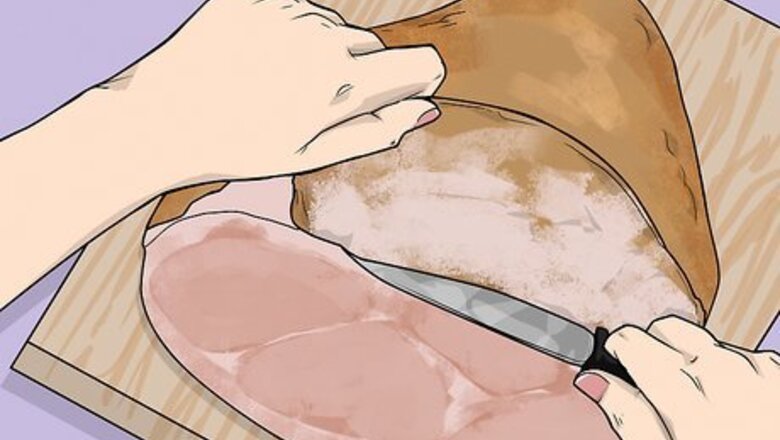
views
Warming the Ham
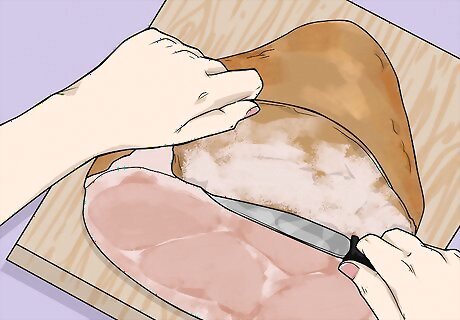
Trim fat and skin from the ham. The outside of the ham will typically have a layer of fat beneath the skin. Using a sharp knife, shave away both the fat and the skin until you reach the pink meat. Do this for all sides of the ham until there is no longer any skin or excess fat.
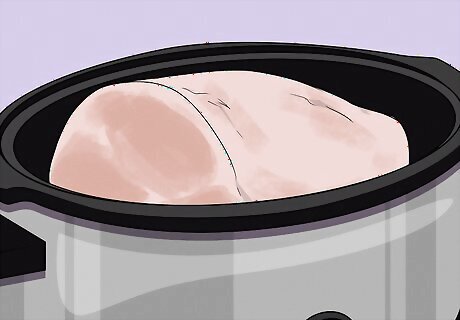
Put ham in the slow cooker. The first ingredient to go inside of the slow cooker is the ham. Place it with the flat side facing down. The rounded side should be facing up towards the cover of the pot. If you are using a bone-in ham that you have not warmed up before, check the end of the bone to see if there is a plastic cap attached. If so, remove the cap before cooking.
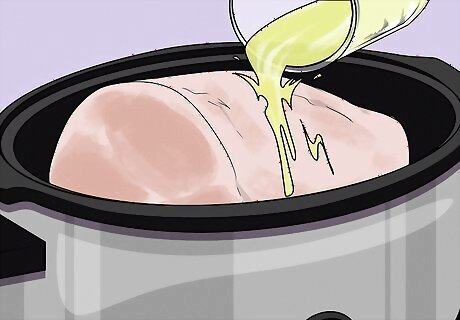
Pour one cup of liquid inside. The liquid will cook the ham while keeping it moist. There are many different types of cooking liquids you can use based on what type of taste you want to give the ham. Water is the easiest and most basic liquid, although it will not give any flavor. You can also try: Chicken broth Cola Apple juice Pineapple juice Ginger ale

Cook between three and six hours. Set the slow cooker to its low setting, and cover the pot. Most hams will reheat in between three and six hours, depending on their size. A three pound ham may take two and a half to three hours whereas a six or seven pound ham may take up to six.
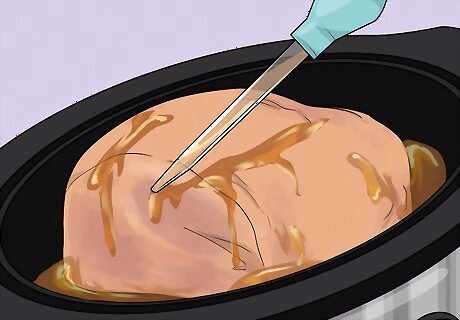
Baste the ham. About an hour before the ham is finished, you should baste the ham using the juices that have collected at the bottom of the basin. Use a baster or a ladle to scoop up these juices, and pour them over the top of the ham to keep the ham moist. If you are glazing the ham, you can use any extra glaze to baste the ham.
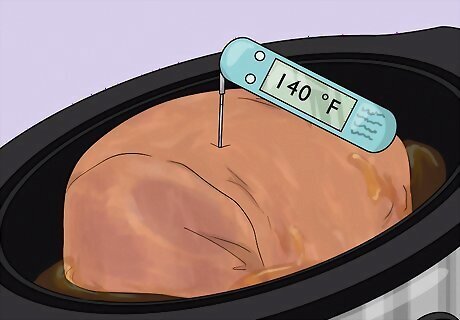
Check the temperature. A reheated ham should have an internal temperature of at least 140 °F (60 °C). Use a meat thermometer, and stick it in the thickest part of the ham. If the ham is not at the right temperature yet, put the top back on. If the temperature is higher, remove the ham immediately so that it does not overcook.
Glazing the Ham

Slice the top of the ham. If the ham is not already sliced, you will need to make marks in the top of the ham before putting it in the slow cooker. Use a sharp knife to cut a grid or diamond pattern on the top of the ham. You should only cut 1/4 inch deep into the ham. This will allow the glaze to reach deep inside the meat.
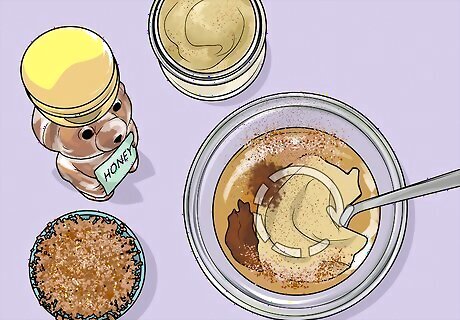
Mix the glaze. The glaze will both flavor the ham and keep it moist. You can use the glaze as a baste as well. Brown sugar, maple, pineapple, cloves, and honey are all popular ingredients in ham glazes. Some recipes you can use for a glaze include: Maple Brown Sugar: 1 cup dark brown sugar, 1/2 cup pure maple syrup Pineapple: 3/4 cup pineapple juice, 1 cup brown sugar, 1/3 cup Dijon mustard, 1/3 cup whole grain mustard Honey Mustard: 1/2 cup brown sugar,1/2 cup honey, 2 tablespoons Dijon mustard, 1/4 teaspoon ground cloves
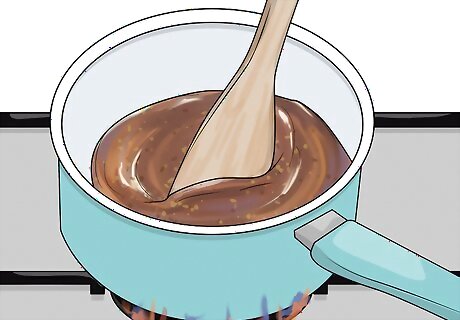
Reduce the glaze. If you want a thicker glaze, you can heat the glaze in a sauce pan on the stove. Keep the heat slow, and heat the glaze until the sugar dissolves. Stir as you heat to prevent the glaze from sticking to the bottom of the pan.
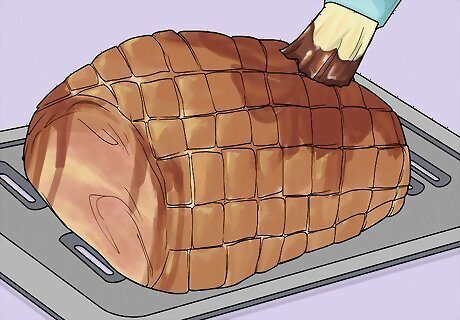
Add the glaze to the ham. The glaze can be added either before you start heating the ham or thirty minutes before the ham stops cooking. A glaze added sooner will impart more flavor the ham, but it may become thin and runny during cooking. A glaze added towards the end will sit at the top of the ham, but it will be thicker. Decide what your preference is, and add the glaze at the appropriate time.

Place the ham under the broiler. Once the ham is done cooking, place it under the broiler for between five and seven minutes. This will caramelize the glaze. Keep an eye on the ham as it is below the broiler to prevent burning or overheating. If you don't want to use the broiler, you can also place the ham inside an oven heated to 425 °F (218 °C) for eight minutes.
Working with Different Sizes of Ham
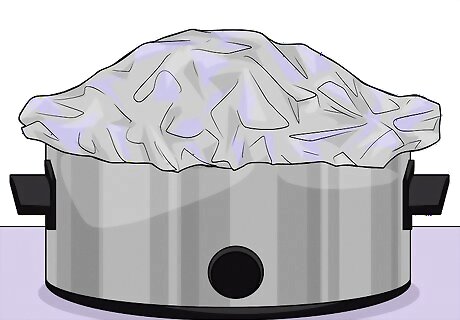
Cover the top of the pot with foil. If the ham is too tall, the slow cooker's lid may not fit. Instead, you can use aluminum foil to make a tent that will cover the ham. Pull the foil over the top of the slow cooker, tearing off a piece that is large enough to cover the entire basin and the ham. Gently press the foil around the top of the pot, making sure that the ham is completely covered. Do not touch the foil while it is cooking; only remove it to check the temperature of the ham. Be extremely careful as you remove the foil, as steam may have built up under the foil. It may be extremely hot.
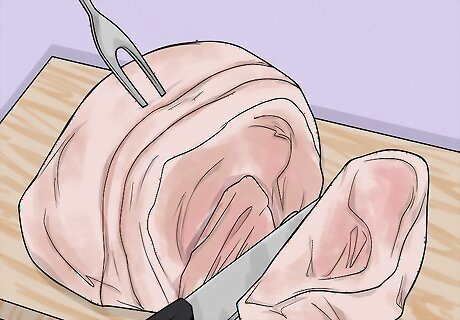
Cut the ham to size. If the ham is too large or awkwardly shaped, it may not fit in the pot correctly. You can cut off pieces of the ham to make it fit inside of the pot. Fit these pieces around the main chunk of ham in the slow cooker. You might also decide to cook them separately or to discard them. If you have a boneless ham, you can cut up the ham however you please so that it fits most conveniently in the slow cooker. If you have a bone-in ham, you should slice parallel above the bone, as most kitchen knives will not be sharp enough to cut into the bone.

Reheat slices of ham using another method. The slow cooker method may not be ideal for ham that has already been sliced into separate pieces off the bone. While bone-in spiral-sliced hams can be reheated before you carve them, ham steaks, slices, and chunks should be cooked using a different method. You can reheat a ham steak or slice in a skillet until it is slightly browned on either side. You can also simmer it with a cup of water for two minutes to remove some of the saltiness. Ham chunks can be reheated by warming them up in a skillet or microwave. You can also add them to soups, omelets, and other recipes. You do not have reheat the chunks before adding them.


















Comments
0 comment